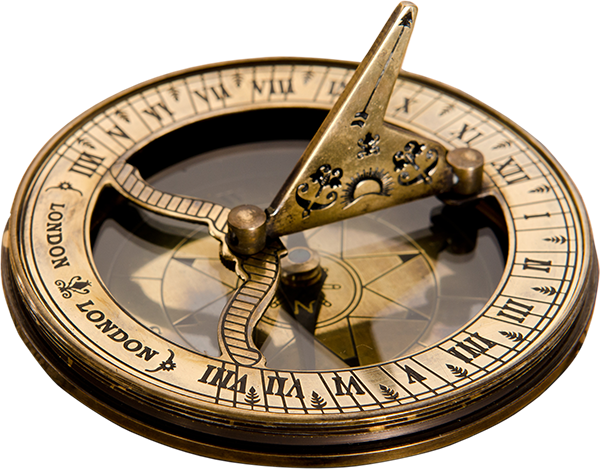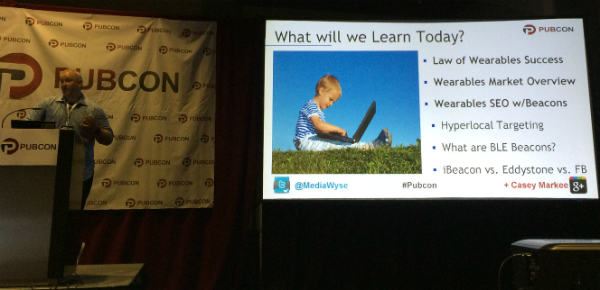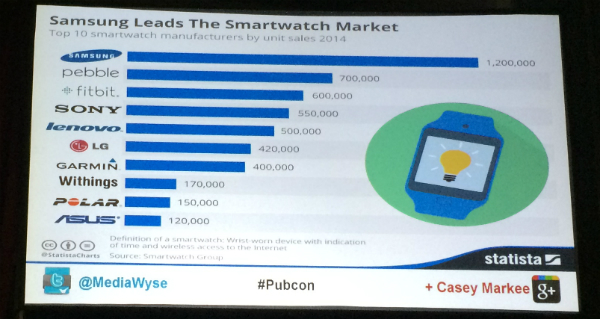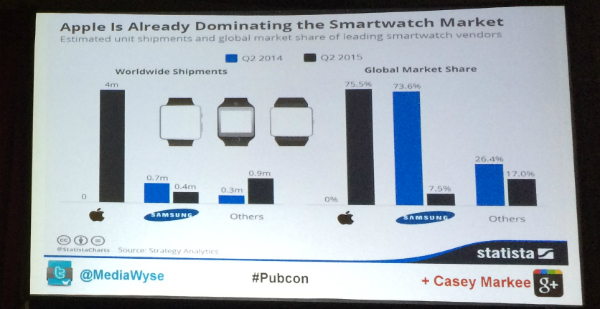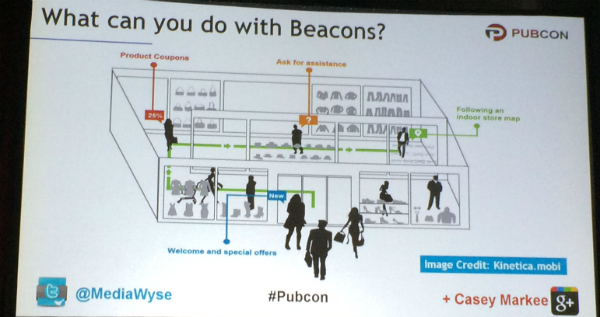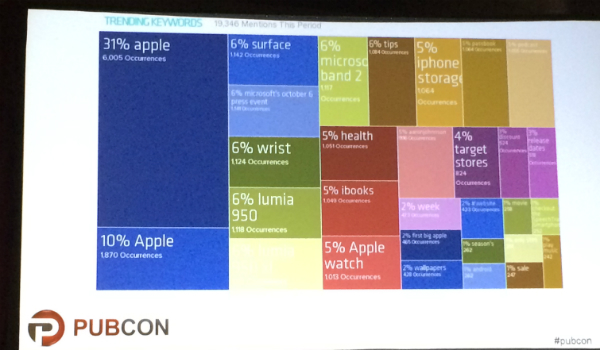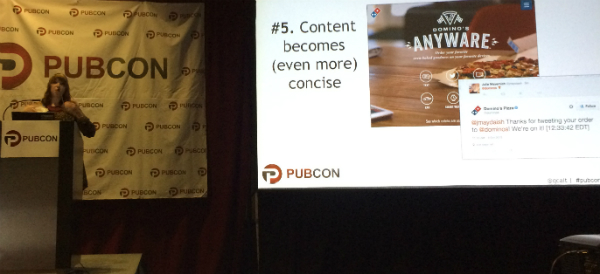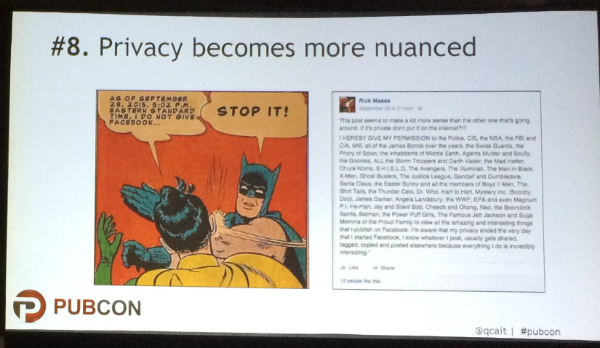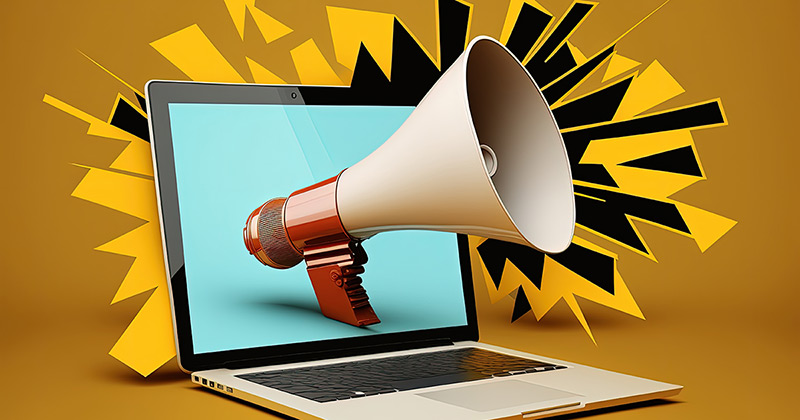Beyond SEO: Marketing for Wearable Technology & Beacons – #Pubcon Liveblog
The Pubcon session called “Beyond SEO: Market Intersection Optimization” is really about marketing to users with wearable technology — including using beacons for hyperlocal marketing, and tips for creating social media and content for wearable devices such as Apple Watches.
Moderator Peter Leshaw (@peterleshaw) is a few thousand miles away from where he lives, yet he can tell us that right now he has five eggs in his refrigerator, and the one farthest to the right is the oldest. He has an app for his Moto360 wearable called Egg Minder. Casey Markee (@mediawyse) and Caitlin Jeansonne (@qcait) will tell us about how wearable devices are affecting social media and everyday life, and how to adopt marketing strategies for wearable tech.
Casey Markee: Wearables Hyperlocal Marketing with Beacons
Beacons are bringing personalized marketing to a whole new realm. Here’s his agenda for this presentation:
“In order to be successful, any given piece of wearable technology has to be useful the entire time it’s on your body.” –Nilay Patel, The Verge
Wearables Market Overview
In 2014, 89 different companies sold smartwatches, mostly Android. The average cost was $189.
Smartwatches are defined as providing time and having a wireless connection.
Compare 2014 to the market in 2015. Apple is the new king of the wearables market.
The only close competitor is Fitbit.
There have been four million Apple Watches sold for $3+ billion in revenue, and it’s the most successful product to date. It only took one day for Apple to sell a million Apple Watches. There’s projection that the Apple Watch will be the most in-demand product of the 2015 holiday season.
Rolex was previously the largest luxury brand revenue generator. Apple is expected to triple their records, making them the new luxury watch king.
Forecast: By 2018, smartwatches alone will move 91.6 million units. A lot of people will have a smartwatch, most likely an Apple Watch, by the end of the year. As SEOs, we must target our clients’ audiences on these platforms. That’s what we’re talking about when we’re talking about wearables SEO.
Beacons: Hyperlocal Targeting
Hyperlocal marketing is delivering a personalized marketing message for a product or service in real-time to target consumers exactly when they need it.
How do you do this? With beacons! The beacon options are:
- Apple’s iBeacon
- Google Eddystone
- Facebook Beacons
Beacon Stack is an industry review site that compares various beacon technology.
How do beacons work?
- Information is broadcasted from a beacon.
- A phone receives information and sends to backend systems.
- CRMs and analytics backend systems receive and process information
- Personalized offers or messages delivered over network
- In-store mobile app experience for customer
What can a consumer do with the help of beacons?
- Get product coupons
- Ask for assistance
- Get a welcome and specific offers
- Follow an indoor store map
Facebook Beacons: Cool, but limited
Facts for marketers:
- Available for any retail or local business with a verified Facebook account.
- Facebook “Places Tips” trigger when within 100 feet of a beacon.
- Serve a “Welcome Note” to visitors.
- Serve prompts to Like the page or check in.
- Feature posts from your page or those of your fans.
Apple iBeacons: App-focused and hot
- App-based – mandatory for messages
- Proprietary – does work on Android with a lot of requests
- Can send messages only through UUID (Universal Unique Identifier)
- No use of EIDs – This is their biggest drawback; you can’t track lost luggage, asset tracking across a fleet of trucks.
Google Eddystone: New Kid on the Block
- This beacon supports URL and app for messaging.
- Anyone can use Eddystone beacons to submit alerts through a URL, UUID, EID.
- Contextual ability is great and more than with other options.
- Restaurants can push happy hour specials. He compares it to the most like Tom Cruise walking through the mall.
Why use beacons? It makes visitors/customers more likely to buy and spend more money!
iBeacon Case Study: Marsh Supermarkets in Indiana
This is the most famous beacon case study. He expects more retailers will make capabilities like this cross-platform with Eddystone next.
Eddystone Case Study: TriMet PTA in Oregon
Arrival and departure date of trains closest to them. It’s like an expanded version of Google Now cards.
If this is new to you, talk to clients and ask if there’s a way for you to provide a personalized option that uses bluetooth beacons.
Caitlin Jeansonne: Apple Watch and Wearables Affecting Social Media Marketing
What are people talking about related to wearables? Here are the trending keywords:
- Health
- Apple Watches
- Holiday gifts
- Target (will be selling the Apple Watch soon)
1. Wearables have the potential to cut through consumers’ natural ad block.
We see over 5,000 branded messages in a day, and we’re pretty good at filtering them out. Because wearable technology is attached to us and tied into our lives, marketers who can tap into that will cut through the noise.
2. The rise of new social communities around connected objects.
There are growing and engaged communities using lots of hashtags and sharing across platforms (Instagram + Fitbit community, for example). Opportunities include finding a way your brand can participate in a community in a meaningful way. Look for micro-influencers.
3. Increased speed of engagement.
When someone posts about a brand, there’s an expectation of a faster response. 42% of people who reach out to a brand expect a response in an hour. Another 25% expect a response in a day. 65% of brands respond within a day – that’s basically the minimum today. As wearables adoption increases, that timeline will likely shorten.
4. More data means more targeting options, but screen size is limited.
5. Content becomes even more concise.
Tell Domino’s your default setting (where you live and your food order), and then you can send a single character — the pizza emoji — to place your order.
Emojis and emoticons are additional things in our toolkit that can shorten the message and the meaning. Think about that in terms of your logo and other imagery. What short snippets of content are you using that your customers see that make them immediately think of you?
6. Storytelling remains key.
This is the heart of all social media platforms. Telling the brand story to connect in a meaningful way is our goal.
Instagram on an Apple Watch is just the image and then you can scroll down to see the caption. Let that image tell the story.
7. Call to action changes.
On the Apple Watch, Twitter app users can’t click a link. Users can retweet, reply, favorite and follow. Think of which of those CTAs make the most sense.
8. Privacy becomes more nuanced.
People will become more aware of the data they are sharing, as well as when and how. When they start to see ads related to a wearable they’re using, they’ll connect that to their device and privacy settings.
Humana, the health insurance agency, lets you tie in all your fitness wearables and gives you points for doing things like exercising, points which you can redeem for Amazon gift cards and the like.
9. Useful content wins.
This is always true. As brands, think of how to provide the most value to customers.
Takeaways
- Know your audience.
- Tell your brand story in a meaningful and concise way.
- Look for opportunities for micro-content.
- Beyond your logo, define brand assets including commonly used images and taglines.
- Seek to provide value.
- Monitor social conversations about your brand/industry.
- Stay on top of wearable technology developments.

2 Replies to “Beyond SEO: Marketing for Wearable Technology & Beacons – #Pubcon Liveblog”
These markets are already widely using wearable tech to track down everything that can be tracked and inform users about their real-time performance: in fitness, sports and healthcare there’re already FuelBands, Jawbone Ups, Fitbits, Trace, Instabit, Checklight and other apps that help measure calories, steps, speed, distance, jump height, rotation, heartbeat, pressure, etc. http://intersog.com/blog/augmented-reality/how-wearable-technology-will-change-future-mobile-paradigm-part-1
LEAVE A REPLY
